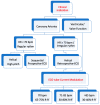CT Coronary Angiography: Technical Approach and Atherosclerotic Plaque Characterization
- PMID: 38137684
- PMCID: PMC10744060
- DOI: 10.3390/jcm12247615
CT Coronary Angiography: Technical Approach and Atherosclerotic Plaque Characterization
Abstract
Coronary computed tomography angiography (CCTA) currently represents a robust imaging technique for the detection, quantification and characterization of coronary atherosclerosis. However, CCTA remains a challenging task requiring both high spatial and temporal resolution to provide motion-free images of the coronary arteries. Several CCTA features, such as low attenuation, positive remodeling, spotty calcification, napkin-ring and high pericoronary fat attenuation index have been proved as associated to high-risk plaques. This review aims to explore the role of CCTA in the characterization of high-risk atherosclerotic plaque and the recent advancements in CCTA technologies with a focus on radiomics plaque analysis.
Keywords: CCTA; atherosclerosis; prognosis; radiomics.
Conflict of interest statement
The authors declare no conflict of interest.
Figures




References
-
- Kuller L.H., Arnold A.M., Psaty B.M., Robbins J.A., O’leary D.H., Tracy R.P., Burke G.L., Manolio T.A., Chaves P.H.M. 10-Year follow-up of subclinical cardiovascular disease and risk of coronary heart disease in the cardiovascular health study. Arch. Intern. Med. 2006;166:71–78. doi: 10.1001/archinte.166.1.71. - DOI - PubMed
-
- Mozaffarian D., Benjamin E.J., Go A.S., Arnett D.K., Blaha M.J., Cushman M., de Ferranti S., Després J.-P., Fullerton H.J., Howard V.J., et al. Heart Disease and Stroke Statistics—2017 Update: A Report from the American Heart Association. Circulation. 2017;135:e146–e603. doi: 10.1161/CIR.0000000000000485. - DOI - PMC - PubMed
Publication types
LinkOut - more resources
Full Text Sources

